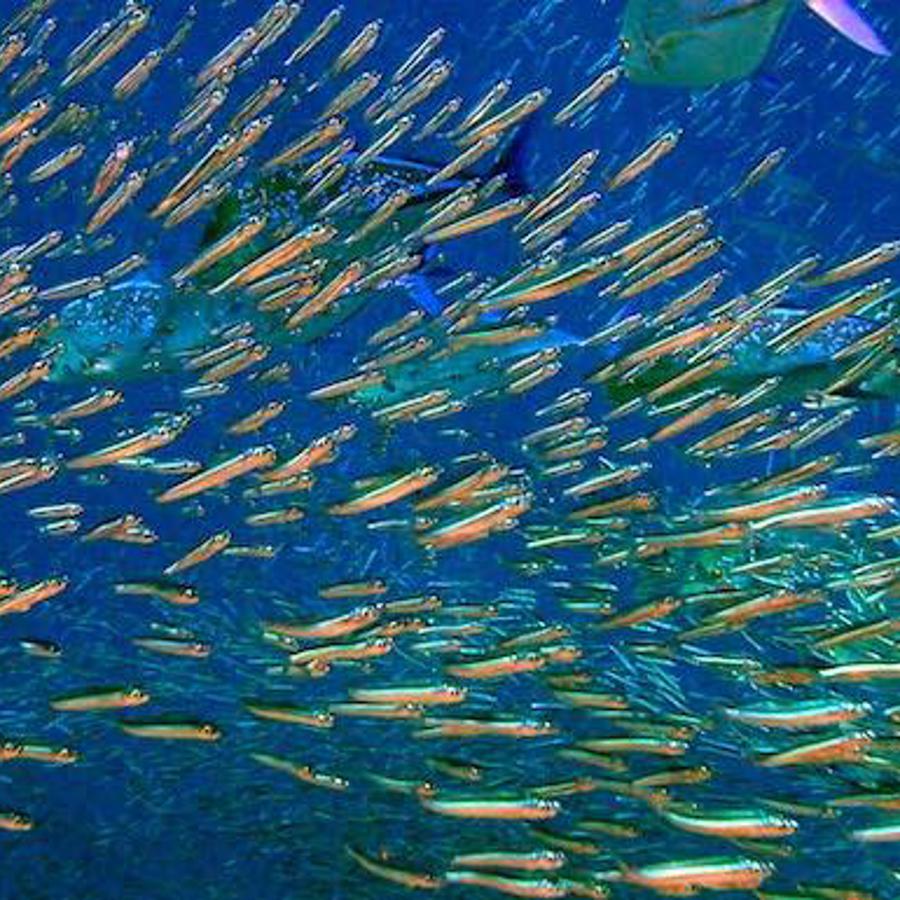
Can fish evolve to resist being caught?
August 7, 2012

- Related Topics:
- Population genetics,
- Environmental influence,
- Animal biology,
- Quirky questions,
- Evolution
A curious adult from Australia asks:
"Will some types of fish that are regularly caught by hook and line eventually evolve a resistance to this type of fishing method?"
Great question! The answer is… maybe.
It is certainly possible that fish will one day become “resistant” to hook and line fishing. After all, as you’ll see below, there are many examples of human hunting and fishing activities affecting the evolution of the species being hunted.
So how might this happen? Well, imagine that the hooks fishermen use require the fish to have a big mouth. Just like other traits within any group of animals, fishes’ mouths come in lots of different sizes.
You can guess what would probably happen. The big mouthed fish would be more likely to get caught and so might be less likely to spawn. Over time, fish with small mouths would come to dominate.
Now these fish would be kind of resistant to hook and line fishing. Until fishermen started using smaller hooks!
Of course this kind of fishing is actually more complicated than simply biting a hook. Fishing with hook and line takes advantage of the fish’s feeding behavior too.
Fish go after lures because the lures mimic the food the fish have evolved to go after. So if a fish avoids a lure that looks like its natural food source, it might also be less likely to eat its natural food. In other words, it wouldn’t do as well because it wouldn’t do a good job finding food.
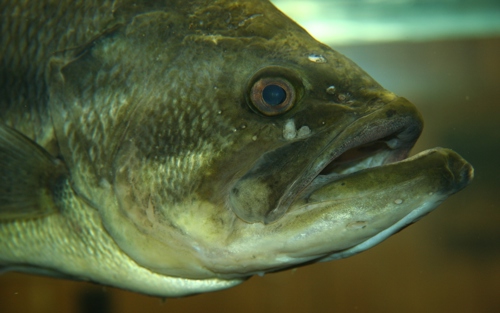
So we have two things working against each other. On the one hand we have fish getting caught and killed because of fishing. This decreases the fitness of these fish.
But on the other hand, these same fish are also more likely to find food. This makes them more likely to reproduce and so increases their fitness. It’s hard to say which would win out.
Now if a fish in the population were somehow able to distinguish between real food and lures, it would have a great shot at becoming resistant. But it would only matter if there were tons of fishing going on. It takes a whole lot of pressure to really affect the genetics of a big population
Notice in these scenarios that the act of fishing didn’t introduce new traits into the population. Any more than antibiotics change a bacterium’s genes to make it resistant. Natural selection usually works on traits that are already in a population.
As you’ll see below, there are definitely populations in which we have become the agents of selection. We are basically wiping out the animals that have the traits we want and allowing the animals we are less interested in to thrive. Survival of the weakest!
What’s worse, we may even have permanently eliminated some of the genes from the population that lead to a number of desirable traits. If so, then these traits are gone from the population forever.
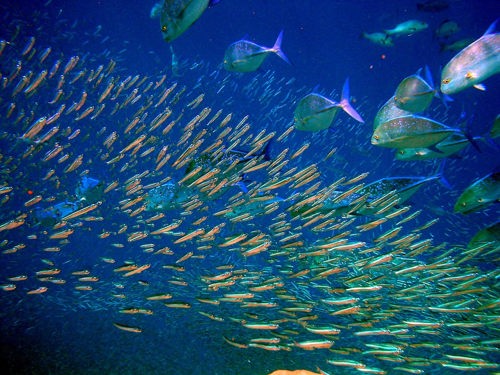
Smaller Fish and Antlers
Fish are an excellent example of a population we’ve influenced. Instead of being resistant to hook and line fishing, we have caused a number of species to grow to a much smaller size. And if we’ve fished hard enough, these changes might be permanent.
Most states have minimum size limits for what fish can be taken by recreational and commercial fisheries. This is so that smaller fish have a chance to grow and have babies before they are caught. But like lots of other regulations, these have some unintended consequences.
Like any group of animals, fish come in all sizes. These sizes are dictated by the genes the fish inherited from their parents.
So some fish have the genes to make them grow large and others have genes that keep them small at maturity. Sort of like the range of height in people. Some are tall and some are short.
The regulations that make it so people only keep big fish favors fish that remain smaller at maturity. Imagine there are a few fish that can have babies when they are below the legal size to be caught, and other fish that can only have babies after they have grown larger than the legal limit.
Legal fishing means the first group will have lots of babies before they are caught while the second group may have no babies. If the fishing is intense enough, the larger fish may be wiped out leaving only the smaller fish behind. Now the individual fish in the population are smaller than they were before fishing.
And this doesn’t just happen in fishing. Another example is deer hunting.
Deer have lots of different sized antlers. Before hunting, big antlers were an advantage. The deer with the bigger antlers were more likely to get a mate.
Now hunters want deer with big antlers. Which means that those deer with the genes for making big antlers are now at a disadvantage. They are being wiped out because of hunting. The end result is a population of deer with much smaller antlers.
This is often not seen as that big of a deal because if we stop fishing or hunting, bigger fish or antlers will return. Except when they don’t. Sometimes because of how the genetics of these traits works, the bigger size of fish or antlers can be lost for the foreseeable future.
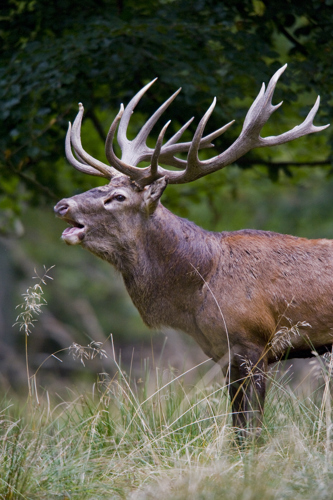
Permanent Gene Loss
As I said before, genes cause traits. So imagine there is a single gene that determines the size of a fish.
Like lots of genes, this gene comes in different versions. Let’s say there is a big (B) version and a small (b) one.
Remember that like people, fish have two copies of each of their genes. This means that the three possible combination of genes (or genotype) are as follows:
- BB
- Bb
- bb
Now finally let’s say that being big is dominant over being small. In our example here, that means that B is dominant over b. Which means that the three combinations of genes lead to the following sizes:

Now imagine that a population of fish is so overfished that every last big one is caught. This would mean that every B version of the gene was eliminated leaving only b. The end result would be that all fish would have the bb genotype and all fish would be small.
There is no easy way to get back the big fish. Without the B’s, the fish are all small. There is no way to pass on bigness to their offspring…there simply aren’t any more big genes in the population.
Think about it like a video you recorded. Imagine you have recorded your kitten doing something silly and posted it to YouTube. It goes viral and now lots of people have it. This video would be the B version of the gene.
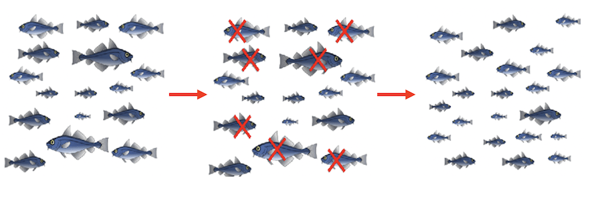
Now imagine that someone hates your kitten video and manages to delete all copies of it including your original. Now the kitten video is gone forever and there is no easy way to re-introduce it. You’ll have to shoot a new video.
The same is true for the B version of the size gene. Once we wipe it out, it is gone. Unless we get lucky and a fish’s DNA gets a mutation that causes a new version to pop up. Like you reshooting the kitten video.
It is probably unlikely that we’d wipe out every B in a whole population. But if we knock the number down enough, big fish may become so rare that they are essentially wiped out from a fishing standpoint. This is like the video being deleted almost everywhere except on a few old computers that no one is using anymore. The video file still exists but no one is watching it.
Unless there is a big advantage to being large, the B gene wouldn’t become more common over time. We will have permanently altered this fish species to be much smaller with only the occasional larger fish. (Click here for why a dominant allele isn’t necessarily the most common one.)
Our B and b genetic example is probably too simple for real life. Size is almost certainly more complicated than we’ve sketched out here with lots of genes involved. But the same ideas can work in even more complicated situations.
So what we do can definitely change the animals we hunt (and the food we grow). If people catch enough fish by hook AND some of the fish have gene versions that make them resistant to biting hooks, then you might end up with a population of fish resistant to hook and line fishing.

Author: Justin Smith
When this answer was published in 2012, Justin was a Ph.D. candidate in the Department of Genetics, studying gene expression, evolution, and synthetic biology in Hunter Fraser's laboratory. He wrote this answer while participating in the Stanford at The Tech program.
 Skip Navigation
Skip Navigation
